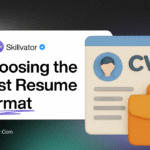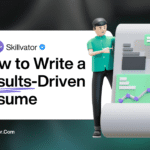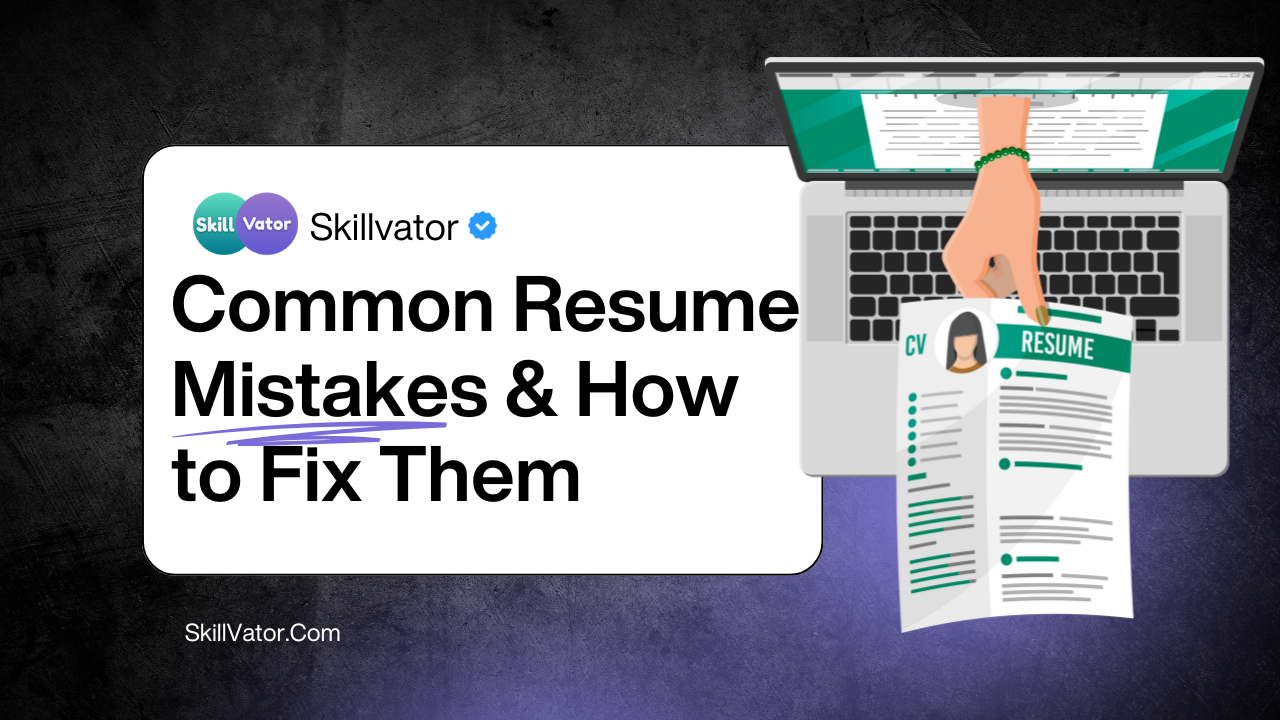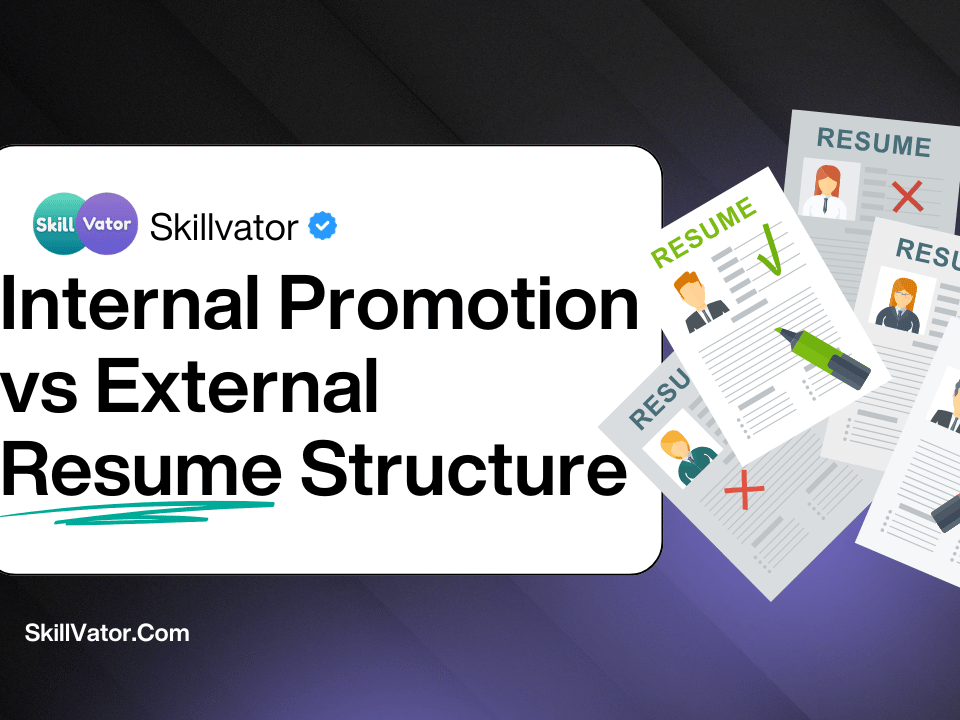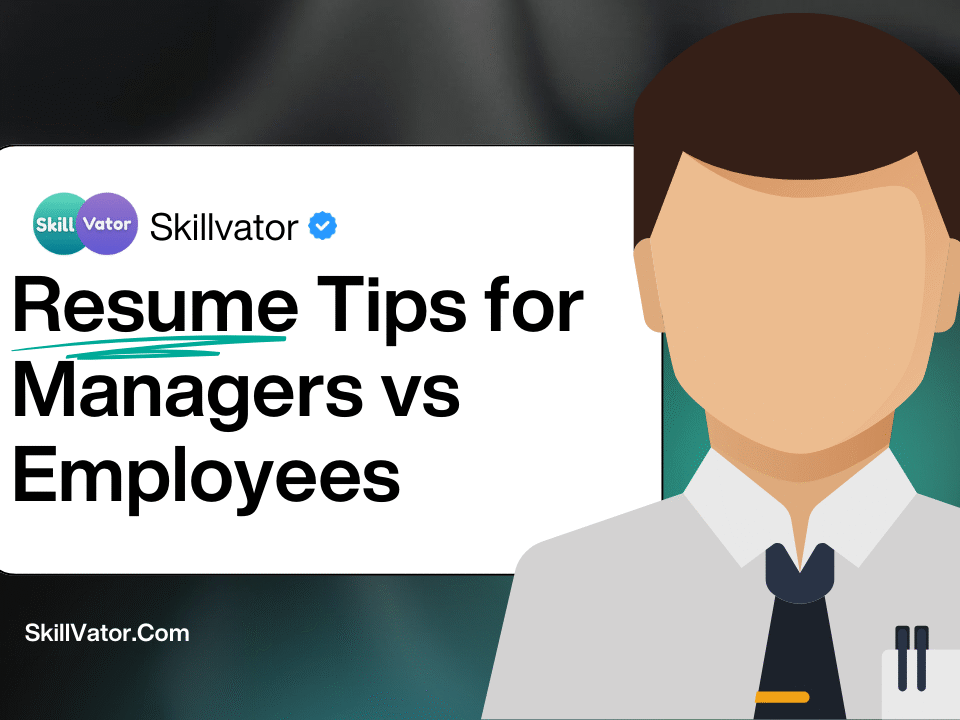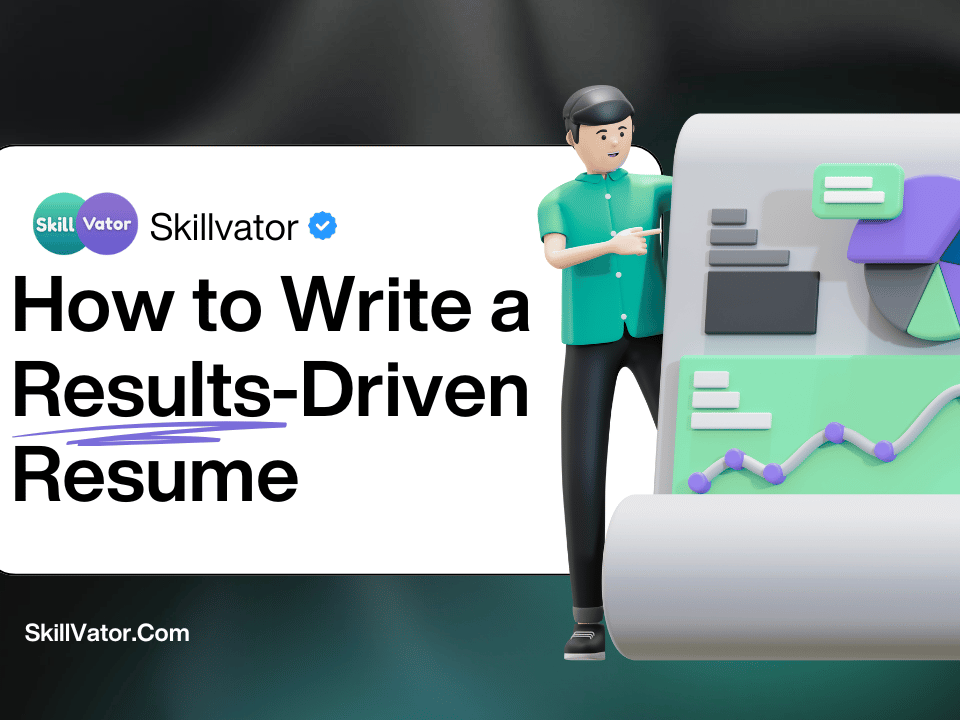This Common Resume Mistakes Maybe destroyed your business and financial situation. Your resume is your professional handshake before you even meet the recruiter. A polished, relevant, and well-structured resume can open doors to new opportunities, while a poorly crafted one can close them instantly.
At Skillvator, we work with professionals at every career stage, and I’ve seen a clear pattern: most rejected resumes fail for the same avoidable reasons. In this guide, I’ll share the most common resume mistakes—and exactly how to fix them—so you can confidently present yourself as the best candidate.
1. Using a One-Size-Fits-All Resume
The mistake:
Sending the same resume to every job posting, regardless of industry, role, or level.
Why it hurts you:
Applicant Tracking Systems (ATS) and hiring managers look for alignment with the specific role. A generic resume lacks targeted keywords and relevant examples, which reduces your chances of passing the first screen.
The fix:
-
Customize your professional summary for each job.
-
Match keywords from the job description (e.g., “project management,” “stakeholder communication”).
-
Highlight the most relevant achievements for the role you’re applying to.
Looking to master every aspect of crafting a winning resume?
Our Resume Building Guide guide covers everything from formatting strategies and keyword optimization to showcasing your skills for maximum impact. It’s your step-by-step blueprint for creating a resume that not only gets noticed but helps you achieve long-term career success.
2. Overstuffing with Buzzwords
The mistake:
Phrases like “results-driven,” “hardworking,” and “team player” without proof.
Why it hurts you:
Recruiters see these vague claims daily. Without evidence, they feel empty and fail to set you apart.
The fix:
-
Pair every skill claim with a measurable achievement:
Instead of “excellent communicator”, write “Led weekly cross-department meetings with 20+ stakeholders, reducing project delays by 15%.”
-
Use action verbs like “implemented,” “orchestrated,” “delivered,” and “accelerated.”

3. Ignoring ATS Optimization
The mistake:
Using overly creative designs, images, or PDF formats that confuse Applicant Tracking Systems.
Why it hurts you:
Your resume may never be read by a human if the ATS can’t parse it.
The fix:
-
Use standard headings like Work Experience, Education, Skills.
-
Avoid tables, graphics, and text boxes for critical information.
-
Save as a plain-text-friendly PDF or Word document.
4. Focusing on Duties, Not Achievements
The mistake:
Listing job responsibilities instead of measurable contributions.
Why it hurts you:
Responsibilities are what you were expected to do; achievements are what you actually delivered.
The fix:
-
Follow the STAR method (Situation, Task, Action, Result).
-
Quantify results:
“Increased sales by 20% in six months by implementing a new CRM workflow.”
5. Poor Formatting and Readability
The mistake:
Dense paragraphs, inconsistent fonts, and no white space.
Why it hurts you:
Recruiters skim resumes in seconds. Bad formatting kills readability.
The fix:
-
Use a clean, professional font (Calibri, Arial, or Helvetica).
-
Keep it to 1–2 pages.
-
Use bullet points for clarity.
Not sure which resume format fits your career best?
Read Choosing the Best Resume Format to discover which structure highlights your strengths, fits your industry, and passes ATS checks—plus get 5 ready-to-use templates to start strong.
6. Forgetting to Highlight Soft Skills
The mistake:
Only listing hard skills, like “Excel” or “JavaScript,” without showing interpersonal abilities.
Why it hurts you:
Soft skills—like adaptability, leadership, and problem-solving—are often what make candidates stand out, especially for leadership or client-facing roles.
The fix:
-
Include soft skills in both your skills section and experience descriptions.
-
Show, don’t tell:
“Mentored 5 junior developers, improving onboarding efficiency by 30%.”
7. Leaving Employment Gaps Unaddressed
The mistake:
Large gaps in your work history without explanation.
Why it hurts you:
Employers may assume the worst or think you’ve been out of touch with industry changes.
The fix:
-
Address gaps in your cover letter or brief resume note.
-
Highlight any freelance work, volunteering, certifications, or skill development during that time.
8. Using an Unprofessional Email Address
The mistake:
Emails like cooldude88@gmail.com or cutiecat123@outlook.com.
Why it hurts you:
First impressions matter, and your email sets a tone.
The fix:
-
Use a professional format: firstname.lastname@email.com.
-
Consider creating a dedicated job-search email account.
9. Not Including Relevant Keywords for AI and Semantic Search
The mistake:
Ignoring semantic SEO principles in your resume content.
Why it hurts you:
Modern ATS and recruitment platforms (even AI-based ones) scan for entity-based connections and Latent Semantic Indexing (LSI) keywords that match the role.
The fix:
-
Integrate LSI keywords naturally: career growth, skills development, professional profile, job transition, team leadership, strategic planning.
-
Mirror industry terminology from the job description.
10. Skipping the Local and Geo Context
The mistake:
Not tailoring your resume for location-specific opportunities.
Why it hurts you:
Some recruiters search for candidates within a geographic radius, and location-relevant achievements can add credibility.
The fix:
-
Add your city and state to your header.
-
Reference local markets or regulations if applicable (e.g., “Managed compliance with Ontario labor laws”).
11. Using Outdated Contact Information
The mistake:
Old phone numbers, inactive email addresses, or missing LinkedIn URLs.
Why it hurts you:
If a recruiter can’t reach you quickly, they’ll move on to the next candidate.
The fix:
-
Double-check phone and email before every application.
-
Include a custom LinkedIn profile link that matches your name (e.g., linkedin.com/in/rahah).
12. Writing in the First Person
The mistake:
Sentences like “I managed a team…” or “I was responsible for…” in the body text.
Why it hurts you:
Professional resumes use an implied first person without pronouns, making them concise and easier to scan.
The fix:
-
Write: “Managed a team of 6 to deliver…” instead of “I managed…”.
-
Keep bullet points action-oriented and direct.
13. Overloading with Irrelevant Experience
The mistake:
Listing every job you’ve ever had, even if unrelated to your current career goals.
Why it hurts you:
It dilutes focus and makes it harder for employers to see your most relevant qualifications.
The fix:
-
Only include roles that add value to your current career trajectory.
-
Use a selective work history to emphasize your strongest achievements.
14. Forgetting to Showcase Career Progression
The mistake:
Listing jobs without showing growth in responsibilities or skills over time.
Why it hurts you:
Employers want to see you’re evolving, not staying stagnant.
The fix:
-
Show promotions, title changes, and expanded duties.
-
Add achievement-based bullet points that reflect increasing responsibility.
15. Using Weak or Generic File Names
The mistake:
Naming your file “resume.pdf” or “mycv.docx.”
Why it hurts you:
Recruiters may lose your file among hundreds, and it looks unprofessional.
The fix:
-
Use:
FirstName_LastName_Resume_2025.pdf -
This helps recruiters find you quickly in their database.
16. Skipping a Final Proofread
The mistake:
Typos, grammar errors, or inconsistent formatting.
Why it hurts you:
Mistakes suggest a lack of attention to detail—critical in most roles.
The fix:
-
Use tools like Grammarly or Hemingway for grammar and readability checks.
-
Print and read your resume aloud to catch small errors.
-
At Skillvator, we recommend having a trusted peer review it before sending.
How to Turn Resume Mistakes into Career Opportunities
Most people see resume mistakes as a setback. But at Skillvator, I’ve learned that they can actually be a launchpad for growth—if you use them the right way. Every error is feedback, and every piece of feedback is a chance to reframe your story, sharpen your professional image, and position yourself for better roles.
Here’s how to take those slip-ups and turn them into advantages.
1. See Mistakes as Data, Not Failures
When you get passed over for a role, it’s easy to assume you weren’t good enough. In reality, many rejections come down to presentation, not potential.
-
If your resume isn’t generating interviews, that’s data telling you something needs adjusting.
-
Maybe your achievements aren’t quantified, your keywords don’t match the role, or your formatting isn’t ATS-friendly.
By treating mistakes as diagnostic signals, you shift from frustration to strategic improvement.
2. Use Each Fix to Strengthen Your Brand
Every resume tweak is an opportunity to refine your personal brand—the perception employers have of you before you meet.
Example:
-
Before: “Responsible for team management.”
-
After: “Led a team of 8, delivering 3 cross-functional projects on time and under budget.”
That one change doesn’t just “fix a mistake”—it reinforces your brand as a results-driven leader.
3. Learn the Language of Your Industry
Many resume mistakes happen because candidates write in their own words instead of using the language of the hiring manager.
-
Research job postings, company websites, and LinkedIn profiles for role-specific terminology.
-
Swap generic phrases like “good communication skills” for precise terms like “stakeholder engagement” or “cross-functional collaboration.”
This small shift increases ATS keyword matching and builds trust with recruiters.
4. Turn Gaps into Growth Stories
Employment gaps are one of the most feared “resume mistakes,” but they can become powerful differentiators if you frame them well.
Instead of hiding them:
-
Highlight skill development during that period (courses, certifications, volunteer work).
-
Show how the break gave you fresh perspective or enhanced soft skills.
Employers value candidates who turn challenges into productive experiences—it signals resilience and adaptability.
5. Create a Continuous Improvement Cycle
A resume isn’t a one-time project—it’s a living document.
Here’s a cycle I recommend at Skillvator:
-
Audit your resume every 3–6 months.
-
Collect feedback from recruiters, mentors, or professional resume reviews.
-
Test changes by sending out tailored applications.
-
Measure results—more interviews mean your updates are working.
This process keeps your resume competitive and ensures small mistakes never snowball into missed opportunities.
6. Build Career Confidence Through Fixes
The real power of correcting resume mistakes isn’t just getting more interviews—it’s feeling prepared and confident in your career moves. When you know your resume accurately reflects your value, you approach applications, networking, and interviews with a stronger mindset.
People Also Ask (and You Should Too)
-
What are the biggest resume mistakes to avoid?
→ Generic resumes, poor formatting, no measurable results, ignoring ATS optimization. -
How do I make my resume stand out to recruiters?
→ Use achievements, tailor for each role, optimize with relevant keywords. -
Should I include all my work history?
→ No—focus on the most relevant 10–15 years.
Final Thoughts from Raha Heydari at Skillvator
Every resume tells a story—but not every story is told well. The good news? Every mistake you make on a resume can be fixed, and each fix increases your chances of landing an interview.
At Skillvator, our goal is to help you build the skills and craft the career tools—like a powerful, mistake-free resume—that open doors.
Before you apply to your next opportunity, take time to review your resume against these common errors. Small adjustments now can mean the difference between getting noticed and getting passed over.
For more strategies, check out our full guide: Resume Building for Career Growth.

